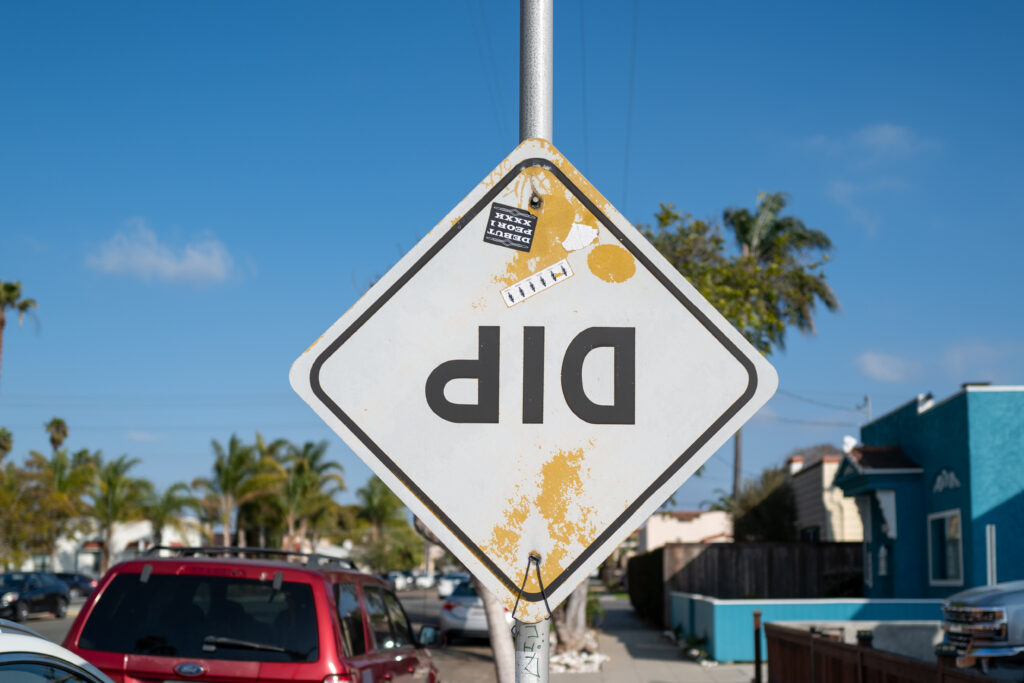While walking along Monroe, approaching Utah, in San Diego’s North Park neighborhood, a street sign beckoned my attention. Consider the Featured Image, captured using Leica Q2, as a metaphor for all things unimaginably crackers about the Golden State. Vitals, aperture manually set: f/2, ISO 100, 1/5000 sec, 28mm; 2:54 p.m. PST, Feb. 10, 2021.
We could start with the SARS-CoV-2 (severe acute respiratory syndrome Coronavirus 2)/COVID-19 lockdowns that have devastated California’s economy; compelled tens of thousands of businesses to permanently close; put millions of people out of work and unable to pay either rent or mortgage; prevented landlords and lenders from collecting the aforementioned and prohibited them from evicting tenants and homeowners; forced families or individuals into homelessness; kept kids out of school for 11 months and counting; opened the prisons, releasing potentially dangerous individuals into the population (many of these former inmates become homeless); and—hell, that’s long-enough list of misery.
Special Election
There are reasons why the Recall Gavin Newsom campaign looks likely to succeed. The group claims that he has “failed Californians”. Some reasons: “Unaffordable housing; record homelessness; rising crime; failing schools; independent contractors thrown out of work; exploding pension debt; and now, a locked down population while the prisons are emptied. Hold Gavin Newsom accountable. Gavin Newsom must go” (full list).
Last week, the campaign reached 1.4 million of the 1,495,709 signatures needed by March 17 to trigger a special election. The group’s goal is 1.8 million, with the extra number meant as cushion should several thousand signatures be disallowed for various reasons (such as not being a California voter).
Unbearable Housing
Perhaps, if living in another state, you heard, read, or saw something about California’s unaffordable housing problem. San Diego had been pricey but reasonable compared to Los Angeles or San Francisco. All that changed in 2020. According to Redfin, the area’s current median house price is $685,000—a 12.7-percent year-over-year increase.
Today, in my neighborhood of University Heights, the lowest-listed property for sale is an 1,158 square-foot condo for $725,975. Next is the community bargain: 1,899 square-foot, 1950s-decor house for $899,900. Both are deals beyond belief when compared to other options ranging from $1.25 million to 2.5 million. Trust me, UH is a lovely place but by no means a wealthy enclave.
Median rent for a one-bedroom apartment in San Diego is $1,810, according to Zumper (a company about which I was unknowledgeable before researching this essay). Single-bed flats in my neighborhood start around $1,450—if you don’t mind 360 to 400 square feet.
Highest Homelessness
People who can’t afford to buy or rent easily end up homeless. Unsurprisingly, California has a huge homeless problem. According to the U.S. Housing and Urban Development’s “2019 Annual Homeless Assessment Report (AHAR) to Congress“: 151,278 people, or 27 percent of the nation’s total; 56,257 are in Los Angeles County. “In terms of absolute numbers, California has more than half of all unsheltered homeless people in the country (53 percent or 108,432), with nearly nine times as many unsheltered homeless as the state with the next highest number, Florida (6 percent or 12,476), despite California’s population being only twice that of Florida”.
Statewide, HUD awards $491,195,402 to 765 homeless programs in California—nearly double the second-highest recipient (New York). In so-called homeless hotels, San Francisco spends between $6,818.18 to $8,8181.82 per person each month on emergency housing. Oh, yeah, the U.S. government pays the bill.
Your Answer?
I could go on and on and on. These items are low-hanging and easily grabbed. If I moved on to culture or politics, the essay would be novel-length and book one of a never-ending series.
Perhaps you would like to answer: “What’s not upside down in California?” Because I can’t.
